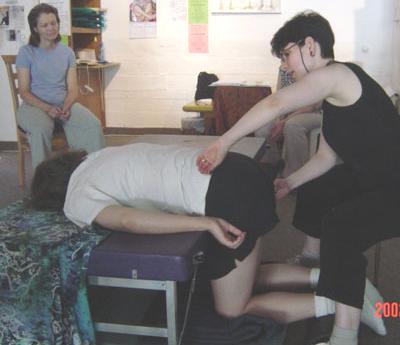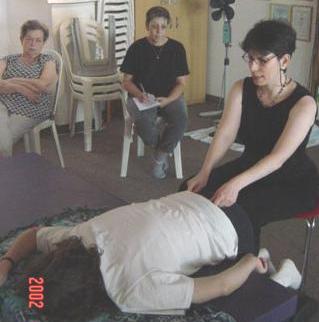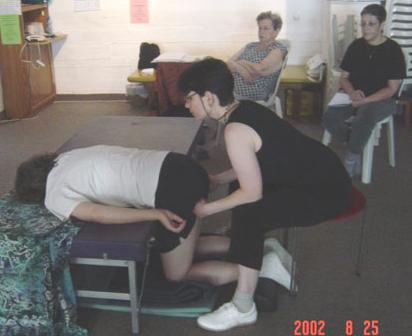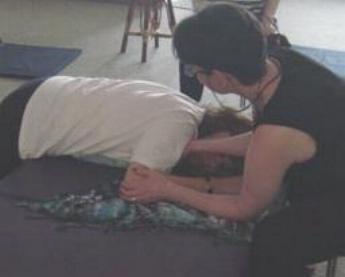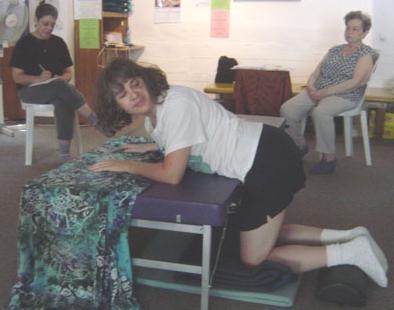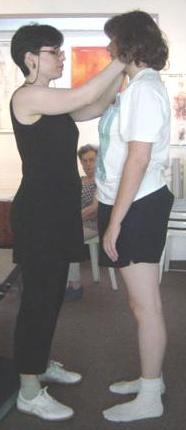
|
The individual lessonFunctional Integration – FI
The Feldenkrais method-The individual lesson/treatment By: Rinat
Levin – Chervin “You cannot teach anything. What you can do, is help someone discover it for himself” – Galileo Galilei The observed
improvements following the individual lesson/treatment are
various, physical and mental. They are expressed in a better
posture, coordination, orientation, breathing, flexibility,
freedom of movement and mood. What is
Functional Integration – FI – the individual lesson/treatment? Functional
integration is performed through non - verbal communication.
Duringa lesson/treatment, the Teacher/instructor physically
mobilizes, with his hands, the student’s body. By doing this,
he/she causes an increase in the student’s awareness to his
body, organs, joints, breathing, ability and ranges of movement.
The Teacher
brings the student, through his hands, into a condition of
learning and understanding. The movements are induced by the
Teacher through rotating, pressing and gently flexing various
parts of the body. The Teacher guides the student as to how he
needs to move and rearrange him self, in order to utilize
himself better. The lesson/treatment is performed effortlessly
and painlessly. It takes the human being into consideration as a
whole system.
The Teacher is well trained to listen to the person and respond to his needs, through the touch of his hands, and the sense conveyed by them. The touch is he mediator, and the movement is the information/message. There is a great importance to the quality of movement, and the pace of the manipulation exerted by the Teacher, in each situation, person and problem at hand. A
lesson/treatment through functional integration lasts about ¾ of
an hour, while considering what needs to be done, and the dosage
that this particular student’s neural system can take in. The
lesson/treatment is performed on a bed, special table or a
chair, and is carried out in various body positions: lying on
the back/ side/ stomach, sitting, standing and more. After a
thorough screenning of the student, the Teacher begins the
lesson. He sets an initial position, which is suitable to that
student and his particular disorder. The Teacher
begins to mobilize the person in various sequences of movements,
in a gradual and continuous manner, in order to improve certain
functions of that person: bending forward better, various ways
of getting up from a lying down to a sitting position,
flexibilizing the back muscles and lengthening the spinal cord,
improving the mobility of the hip joints, the knees and the
shoulders, flexibilizing the thorax muscles, exercising
breathing in different paces according to daily situations,
balancing between the flexors and extensors muscles,
strengthening the abdomen muscles, developing one’s
coordination, and more. Three real life cases
Here are three
very interesting people who I taught and work with using
Functional Integration. The pace and manner of lesson/treatment
were specifically suited to each person and each problem. The
results and the learning of each person on his body and mind
were unique to that person. The names were altered, and bear no
connection with the people appearing in the photographs.
Dr. Cohen
Dr. Cohen, a
55 year old female physician, came after 20 years of suffering
from bulimia (an
eating disorder characterized by uncontrollable binge eating)
and depression. For the
past few years, she is no longer bulimic. She eats normally,
thanks to a series of psychological and psychiatric
lesson/treatments, and some effective acupuncture
lesson/treatments. However, in the past few months she lost 3-4
kilos, and still suffers from restlessness, anxiety, depression,
constipation, heartburn and oesophagus pain.
Some of the
best doctors have made her undergo various physiological checks
of the digestive system, the oesophagus muscle, liver scan, and
heart and heart performance under strain checks. All the checks
findings were normal. Her voice was husky and strained, her
breathing shallow and short. Her way of sitting was bent and
tense. In our conversation, she emphasized her achievements in
life raised 2 daughters, excelled in her studies and her job,
and said that she was very active, diligently exercising every
morning on the floor and riding on exercycle.
She said she
had a strong will to get rid of the problems and pains, and is
prepared to do everything to improve her condition. She then
turned to me two big, wide open, wishful eyes and asked: “do you
think you can help me?” I replied positively, and added that she
will need to be attentive to the message transmitted through my
hands and to the movements through which I will guide her, and
while doing so she will have to notice the changes in them. She
nodded and said: “you are giving me a lot of hope and energy”.
In the first
lessons, her body was very strained and tense. I began the first
lesson by laying my hands on that area of her back corresponding
to the location of the oesophagus, while she lay on her side.
She noted that this area was very sensitive and that this is the
area where the acupuncturist always treats with the needles. The
muscle tone in that area was tremendous. Her ribs hardly moved
and her breathing was barely noticeable. I pressed the
vertebrae, contracted and gently pressed the muscles in that
area. I moved the shoulder joint, the hip and the ribs in
relation to that area. I worked with her on making sounds and
moving the jaw and the mouth while exhaling, which she found
quite amusing.
When I moved
her shoulder joints in circular movements, I found great
difficulty in her movement and very limited ranges of movement,
and she said: “I am holding the shoulder so hard, I wish I
could let go”. The hip joints movement was stiff. When rolling
her pelvis, the body squeaked and bumped. Her neck was strained,
and when lifting her head, she did not easily let go of bearing
her head’s weight, even when requested to do so.
After the
lesson, she said she felt calmer and more relaxed, and when
standing she felt longer and more stable. I suggested some
improvements to her home exercises.
When she came
to the second lesson, she said she felt much better, almost free
of pain, but she was afraid that the pains would return, and had
neither the time nor the energy to handle that.
During the
lesson, she told me she has a friend who tells her: “You never
rest. You are always worried, tense and hard as steel. From the
sound of your voice, people always think you are sick or have a
cold”.
At the end of
the lesson, while lying on her back, she said she wanted to go
to the toilets to evacuate her bowels. She was also a bit
flatulent and apologized for it, but I commented that it was a
good thing, a wonderful sign that she lets her body be a little
more relaxed and free. Indeed, I noticed during the lesson as
well, that she lets her muscle tone be a little lower, and the
movement of her joints easier.
When she sat,
she started crying and said:
“this is
something new and pleasant that I never felt before. I thought
that my body is beyond salvage, that there is no hope for me. I
treated my body like it was a wreck, a piece of junk, I cannot
believe I have reached such state”.
When she stood
up, she was smiling already. Her feeling was good, again she
said she felt longer and more stable, and told me again about
her morning exercises. After the fourth lesson she called me
excitedly and said: “I had a wonderful week, no pains, no
worries, no tension, no anxiety. Even the morphine my doctor
husband gave me once, at a time of distress, did not help me as
much as your lessons did.
Danny
Danny, a young
man of 26 years, was injured in a car accident. His brain was
damaged and he was in a state of coma for about half a year. His
condition was considered “vegetative”, and the doctors gave up
hope for his return to partial or full functioning. In spite of
this, his parents decided to try every possible way to change
his state and improve his functioning. His parents transferred
him to a private hospital and tried several alternative methods,
such as: reflexology, healing and other, but no progress was
observed. They came to me following a recommendation made by the
hospital where the Feldenkrais method is being
practice.
On our first
meeting at the hospital, Danny lay in bed with his hands
strongly crossed on his chest, his fists closed-tight, all
sweaty. His right leg was bent, so that the knee was very close
to the stomach, and the angle between the hip and the thigh,
very acute. This leg was turned left, on top of the left leg,
without any support beneath it, and the pelvis lay stiffly
rotated to the left. The hip joint was extremely rigid.
His mother
told me that he had a severe pressure wound under his right
knee, resulting from bending it so strongly, and that a few
months ago he was operated to remove the tendon (had a
tendonectomy surgery) on one side of the leg. She added that
another tendonectomy surgery was being considered, to remove the
tendon on the other side. His left leg was laid long on the bed,
and his big toe stretched towards the face, while all other toes
faced the other way, in one line with the rest of the body (this
is the “Babinsky sign” – a sign of an injured lateral
corticospinal tract). The vision in his right eye was normal.
His left eye would open and move but its vision was impaired.
Danny did
not talk, just groaned. He sighed faint, meaningless sighs when
he felt pain, or when it was hard to breathe. He breathed
through a cannula ( a sort of pipe which inserted through an
opening at the bottom of the throat) as well as through his
mouth and nose. He was not able to eat by himself. His way of
sitting in a wheelchair was sloppy, his back bent to the right,
and his head falling backwards to the right.
During the
lessons, I stimulated Danny’s nervous system as much as
possible, in order to arouse new paths for conveyance of
impulses and information. I worked on his feet through my hands
and an artificial floor.
In the
beginning, Danny hardly let me touch his feet. He would groan
and open his big eyes. With time, step by step with the
improvement in the movement of the joints in his toes, ankles,
knees and hips, he let me touch his feet. I would ask him to
raise and stretch his leg long, and he would do it. I worked
with a big rubber ball, on which I leaned his leg, and taught
him to voluntarily exert power and let go. He learned to push
the ball and cease, upon my request, and learned to place his
right leg bent, in a widely spaced angle, without leaning to the
left.
After several
weeks the pressure wound healed. The doctors re-examined Danny
and were marveled to find his tremendous progress. They reported
an improvement in his responsiveness to stimuli, and recommended
not to perform surgery to remove the second tendon.
Together with
my work on his feet, I worked on his very strained upper body.
In the beginning I worked by pressing and contracting towards
the center of the body, like his natural posture at present.
After his
muscle tone was lowered, I was able to move his arms in
lengthening motions, and circular motions, moving them right and
left, moving along the center of the body towards the face and
forehead, move his hands from right to left on his mouth, and
even perform some movements independently, by himself.
The nurses
told me that when I was not around, Danny exercised alone the
movements I do with him during the lesson. I prepared for Danny
an audiocassette for practice when I am not around. Along that
I began to work with him on combined movements of legs and arms
together.
Danny reached
a state where, at time of rest, he lay with his arms long and
calm, his breathing easier and his thorax more relaxed and free.
Following the improvement in his breathing, the doctors
recommended to remove the cannula and close the opening at the
bottom of his throat.
I have been
treating Danny for half a year, twice a week, and he began
drawing, writing letters and numbers and extending his hand in
greeting. His way of sitting in the wheelchair improved, he sits
more upright, no longer needs the support previously needed to
hold his head from its right side. He controls salivation, his
toes are relaxed and the Babinsky sign is barely noticeable.
Chaim
Chaim, a 52
year old, senior industrial manager, came to me complaining
about lower back pain which also projected pain onto his left
leg. He reported difficulty in walking, especially at work when
supervising working teams. He was visibly limping, dragging his
left leg. When walking, his body leaned to the right.
In his
walking, I noticed heaviness, “parasitic” movements accompanying
his motion, and a lot of fear from falling down or from pain,
which kept bothering him.
He even told
me that he felt disabled, as if physically handicapped “you may
find it amusing, but I am not able to dance at social events”
In our first
lesson, I noticed that the movement of his pelvis, to various
directions while lying on his side, are tense and not free. His
feet and fingers were stiff and almost impossible to move. His
movements were very typical to disc herniation.
When I moved
his shoulders, I found that his upper body was freer, with
relatively good mobility from shoulders to ribs. In spite of
this, his breathing was very shallow. I revived his breathing by
moving the ribs and thorax.
After that, I
moved on to activating the shoulder and hip joints by slightly
pulling and pressing one towards the other and one along with
the other, in order to create motion between the vertebrae, and
in order to project from these movements and put them later into
practice when walking. I moved his shoulders and ribs, then we
practiced hip and shoulder movement of opposite sides, while
standing and walking. I taught him a few ways of walking, some
of which put a grin on his face.
When I guided
him to a “normal” way of walking, with opposite side arm
(shoulder) and leg (pelvis), he faced inconvenience and
difficulties, and even stopped breathing. It was a wonderful
trial and error test, and when I explained that this is really a
regular way of walking, he was surprised and tried to prove
himself by repeating the movements again. I requested him to do
the clumsiest, least spectacular movement, and avoid trying hard
or putting any effort. He was a bit confused and perplexed, then
started moving and performed it more efficiently and easily,
than before.
In the
following lessons, we worked in a kneeling position (the knees
lean on the floor, spaced at body width, with stomach leaning on
the bed, from waist to head), and lying on the side. Through
gentle movements, I illustrated to him alternative possibilities
of movements of his back vertebrae, in different situations,
using patterns that were habitual and familiar to him, as well
as directions that were new to him.
One lesson,
Chaim told me that his doctors indeed confirmed that he had two
adjoining, herniated discs (between the S1-L5 and the L4-L5
vertebras), and that there was pressure exerted on a nerve, thus
causing his pains. They recommended him to rest, work fewer
hours per day, not exercise, take various pain killing
medicines, and stretch. He went on: “I keep coming to you
despite doctors instructions. I do not take medicines, and do
not stretch. After every lesson, I feel better, and I think this
is the right way for me”.
After 6
lessons, Chaim’s movement and walking coordination improved. His
awareness to the way he moves grew. The limping, fear and pain
were gone and he returned to normal functioning at work and in
social life.
The
Feldenkrais method, therefore, deals with internal learning
processes, of “know yourself” (words attributed to Socrates).
The way of learning is like that of a baby learning to roll or
crawl for the first time. The form of learning is that of trial
and error. The person learns to move while sensing and thinking,
which in turn increase his awareness and his sensitiveness to
his breathing, movement and the different relations between the
various body systems. The Teacher mobilized the student through
gentle, complex movements which are neither mechanic nor
aggressive. Functional integration is a task of instant
information processing.
Sensing and
thinking while moving, and activating the nervous system,
initiate internal processes, which are expressed in the
preservation and useful maintenance of the “correct” habits.
Along that the teacher offer new possibilities for changing the
“incorrect” habits, and enable the student to notice the
differences between them. This way of learning is not the kind
of learning based on repetition, or storage of information.
The observed
outcomes are various and specific to the individual or case at
hand: in various cases of back and orthopedic problems, the
students report an ample solution. The pain is gone, the
flexibility and mobility return to areas of once limited
mobility, the breathing improves, the student stands more
upright and learns new, possible alternatives for movement, in
which he can activate his body in a better, more vital way in
his everyday life. Among cerebral palsy (CP) patients and those
with neurological problems, there is an observed improvement in
the freedom of movement, fewer convulsions, increased control on
salivation, urination and movement, and better responsiveness to
internal and external stimuli. In mental problems such as
anxiety, depression, nervous stomach and general stress, one can
observe an increased self-confidence, better mood and self
image, and increased mental /emotional stability, along with the
improvement in physical posture.
Freedom in
movement, and lower muscle tone in previously tense, contracted
areas, bring about a sensation of calmness, peace, relief and
deeper understanding of the self responsive causes to the
problem.
To sum up, the
Feldenkrais method is an educational method to improve man’s
motor skills, by developing his awareness to his body and the
way he moves.
The method is
essential for those who suffer from orthopedic problems
(scoliosis, disc eruption, spondylosis, knee problems, back
pains, neck pains, flat feet etc.), neurological illnesses
(Parkinson’s disease, multiple sclerosis etc.), brain injuries
(due to car accidents, cerebral palsy etc.), mental problems
(anxiety, post traumatic syndrome, depression, bulimia, nervous
stomach etc.), and other.
Published in:
“Briut al-burya”, an Israeli magazine of alternative medicine.
אינטגרציה פונקציונלית - FI
השיעור האישי בשיטת פלדנקרייז מאת: רינת לוין-צ'רבין "אינך יכול ללמד דבר. כל שביכולתך לעשות הוא לעזור לאדם לגלות זאת בעצמו" גלילאו גליליי
השיפורים הנצפים לאחר הטיפול האישי הם מגוונים – פיזיים ונפשיים. מהי אינטגרציה פונקציונלית – (FI) – הטיפול האישי? אינטגרציה פונקציונלית נעשית בצורת תקשורת בלתי-מילולית. בטיפול המטפל מניע בכפות ידיו את גופו של המטופל, באופן פיזי. על-ידי כך הוא גורם להעלאת המודעות של המטופל לגופו, לאיבריו, למפרקיו, לנשימה, ליכולת ולטווחי התנועה שלו. המטפל מביא את המטופל לידי למידה והבנה דרך ידיו. התנועות נעשות על-ידי המטפל באמצעות רוטציות, דחיסות ולחיצות עדינות של חלקים שונים בגוף. המטפל מדריך את האדם כיצד הוא צריך לנוע ולארגן מחדש את המערכת שלו. במטרה לעשות שימוש יעיל יותר בעצמו. הטיפול נעשה ללא מאמץ או כאב. הוא לוקח בחשבון את האדם כמערכת שלמה. המטפל מיומן להקשיב לאדם ולצרכיו דרך המגע והתחושות של ידיו. המגע הוא המתווך והתנועה היא המסר. יש חשיבות רבה לאיכות התנועה ולקצב של המניפולציה בכל מצב, בכל אדם ובכל בעיה. טיפול באינטגרציה פונקציונלית נמשך כ-¾ שעה, תוך התחשבות במה שנדרש לעשות ובמינון שמערכת העצבים של המטופל המסוים מסוגלת לספוג. הטיפול נעשה על מיטת טיפולים או כסא, ומתבצע בתנוחות גוף שונות: בשכיבה על הגב, הצד, הבטן, בישיבה, בעמידה ועוד. לאחר הערכה יסודית של המטופל, המטפל מתחיל את השיעור. הוא קובע תנוחה התחלתית מתאימה עבור אותו אדם ובעייתו. המטפל מתחיל להניע את האדם ברצפי תנועה מגוונים, באופן מודרג והמשכי, במטרה לשפר תפקודים מסוימים אצל האדם: שיפור כפיפה לפנים, קימה משכיבה לישיבה בצורות שונות, הגמשת שרירי הגב והארכת עמוד השדרה, שיפור תנועתיות מפרקי הירכיים, הברכיים, הכתפיים, הגמשת שרירי בית החזה, תרגול נשימה בקצבים שונים בהתאם לסיטואציה ביומיום, איזון בין השרירים הכופפים והזוקפים, חיזוק שרירי הבטן, פיתוח קואורדינציה ועוד. שלשה מקרים מהחיים להלן שלשה מקרים מעניינים מאד בהם טיפלתי באמצעות אינטגרציה פונקציונלית. קצב ואופן הטיפול הותאמו ספציפית לכל אדם ולכל בעיה. התוצאות והלמידה של כל אדם על גופו ונפשו היו מיוחדות לו. שמות האנשים בדויים, ואין להם כל קשר לאנשים המצולמים בתמונות. ד"ר כהן ד"ר כהן, רופאה בת 55, הגיעה אלי לאחר 20 שנה שבהן סבלה מבולמיה (התקפי זלילה בלתי נשלטים) ומדיכאון. בהשנים האחרונות היא כבר אינה בולמית, היא אוכלת רגיל, וזאת בזכות סדרת טיפולים פסיכולוגיים, פסיכיאטריים, וכן טיפולים באקופונקטורה שעזרו לה. אך בחודשים האחרונים ירדה בכ–3-4 קילו, ועדיין סובלת מחוסר שקט, חרדה, דיכאון, עצירות, צרבת, וכאבים בוושט. היא נשלחה על-ידי מיטב הרופאים לבדיקות פיזיולוגיות שונות של מערכת העיכול, שריר הושט, מיפוי כבד, ובדיקות מאמץ ולב, וכל הבדיקות נמצאו תקינות. קולה היה צרוד, מאומץ, נשימתה רדודה וקצרה. ישיבתה היתה כפופה ומתוחה. היא הדגישה בשיחתה את הצלחותיה בחיים (ילדה וגידלה 2 בנות, הצטיינה בלימודיה ובעבודתה), וסיפרה שהיא מאד אקטיבית, בכל בוקר עושה תרגילי התעמלות על הרצפה ועל אופני כושר, ומתמידה בכך מאד. היא אמרה שיש לה רצון עז להיפטר מן הבעיות ומהכאבים, ומוכנה לעשות הכל כדי שמצבה ישתפר. אז היא הפנתה אלי שתי עיניים גדולות, פקוחות ומלאות ציפייה, ושאלה: "את חושבת שתוכלי לעזור לי?". עניתי בחיוב, והוספתי שהיא תצטרך להיות קשובה למסר שאני מעבירה אליה בידי, לתנועות שבהן אנחה אותה, ותוך כדי כך יהיה עליה לשים לב לשינויים המתרחשים בהם. היא הנהנה בראשה ואמרה: "את נותנת לי הרבה תקווה וכוח". בשיעורים הראשונים גופה היה מאד מאומץ ומתוח. התחלתי את השיעור הראשון בהנחת כפות ידי באזור הגב המקביל לאזור הושט, כשהיא שוכבת על הצד. היא ציינה שזהו אזור מאד רגיש אצלה ושזהו האזור בו תמיד היה האקופונקטוריסט מטפל בה תמיד עם המחטים. טונוס השרירים באזור היה עצום, צלעותיה בקושי התנועעו, נשימתה כמעט ולא נראתה. דחסתי את החוליות, כיווצתי ולחצתי בעדינות את השרירים באזור זה. הנעתי את מפרק הכתף, הירך והצלעות ביחס לאותו אזור. עבדתי איתה על הוצאת קולות, תנועות לסת ופה בזמן הוצאת האוויר, וזה די שעשע אותה. כשהנעתי לה את מפרקי הכתף בתנועות מעגליות גיליתי קושי רב בתנועה וכן טווחי תנועה מאד מצומצמים, והיא אמרה: "הוי, כמה שאני מחזיקה את הכתף, הלוואי שיכולתי לעזוב שם". תנועת מפרקי הירכיים הייתה נוקשה, בגלגול האגן נשמעו חריקות ונראו קפיצות, צווארה היה מאומץ, ובהרמת ראש לא עזבה את משקלו בקלות, גם כשביקשתי. לאחר השיעור היא אמרה שהיא מרגישה יותר נינוחה ורגועה, בעמידה חשה ארוכה יותר, יציבה יותר. הצעתי לה לשפר את תרגילי הבית. כשהיא הגיעה לשיעור השני סיפרה שהרגישה הרבה יותר טוב, כמעט ללא כאבים, אך היא מפחדת שהכאבים יחזרו, ואין לה זמן וכוח לזה עכשיו. תוך כדי השיעור היא סיפרה לי שיש לה חברה שאומרת לה: "חנה, אין לך אף פעם מנוחה. את תמיד דואגת, מתוחה וקשה כמו ברזל. הקול שלך – תמיד חושבים שאת מצוננת או חולה". בסוף השיעור, בשכיבה על הגב, היא אמרה שיש לה חשק ללכת לשירותים לפעולת מעיים, כמו-כן היא שחררה גזים והתנצלה על כך, אולם אני הערתי שזה טוב, שזה סימן נהדר שהיא נותנת לגופה להיות קצת יותר נינוח וחופשי. ואכן, גם בזמן השיעור חשתי שהיא מאפשרת לשרירי גופה להיות בטונוס נמוך יותר, ולתנועתיות המפרקים להיות קלה יותר. כשהתיישבה היא החלה לבכות, ואמרה: "זה משהו חדש ונעים שבחיים לא הרגשתי, חשבתי שאין כבר מה לעשות עם הגוף שלי, שאין לי תקווה, התייחסתי אליו כמו אל שבר כלי, כאל גרוטאה, אני לא מאמינה שהגעתי למצב כזה". כשקמה לעמידה כבר חייכה, תחושתה הייתה טובה, שוב אמרה שהיא חשה ארוכה יותר, יציבה יותר, וחזרה לספר לי על תרגילי התעמלות הבוקר והאופניים שהיא עושה כל יום. לאחר השיעור הרביעי היא התקשרה אלי בהתרגשות ואמרה: "עבר עלי שבוע נהדר, בלי כאבים, בלי דאגה, בלי מתחים. אפילו המורפיום שבעלי הרופא נתן לי פעם במצב של מצוקה לא עזר לי כמו שהשיעורים שלך עזרו". דני דני, בחור צעיר בן 26, נפצע בתאונת דרכים, נפגע מוחו והיה במצב של קומה (תרדמת) במשך ½ שנה. מצבו הוגדר כצמח, והרופאים הרימו ידיים לגבי חזרתו לתפקוד חלקי/מלא. למרות זאת, הוריו החליטו לנסות כל דרך אפשרית שתוציא אותו ממצבו ותשפר את תפקודו. הוריו העבירו אותו לבי"ח פרטי וניסו שיטות אלטרנטיביות אחרות, כגון: רפלקסולוגיה, הילינג ועוד. אך התקדמות לא נראתה. הם הגיעו אלי על-ידי המלצה מבית החולים שבו עוסקים בשיטת פלדנקרייז. בפגישתנו הראשונה בבי"ח דני שכב במיטתו, כשידיו מוצלבות זו על זו בחוזקה, על בית החזה, ואגרופיו קפוצים, כולו מזיע. רגלו הימנית הייתה מכופפת, כך שהברך קרובה מאד אל הבטן, והזווית שבין השוק לירך הייתה קטנה מאד. רגל זו נטתה שמאלה מעל לרגל הימנית בלי שום תמיכה מתחתיה, והאגן היה מונח ברוטציה נוקשה שמאלה. מפרק הירך היה קשיח ביותר. אמו סיפרה לי שיש לו פצע לחץ גדול מתחת לברך ימין מרוב שהוא מכופף אותה כך כ"כ חזק, ושלפני מספר חודשים עשו לו ניתוח לכריתת הגיד בצד אחד של הרגל. היא הוסיפה שהוא מועמד לניתוח נוסף לכריתת הגיד בצד השני. רגלו השמאלית הייתה מונחת ארוכה על המיטה, ובהונו הראשונה, הגדולה ביותר, שלוחה לכיוון הפנים, לעומת שאר הבהונות שפנו קדימה בהמשך הגוף למטה (סימן בבינסקי – BABINSKI SIGN – שמעיד על פגיעה ב- LATERAL CORTICOSPINAL TRACT ). ראייתו תקינה בעין ימין, עינו השמאלית נפקחת ומתנועעת, אך ראייתו בה לקויה. דני לא דיבר, רק השמיע נהמות, אנחות עמומות בלתי מובנות כשחש כאב, או כשקשה היה לו לנשום. הוא נשם דרך קנולה (פתח בתחתית הגרון), ודרך הפה והאף. לא היה מסוגל לאכול לבד. ישיבתו בכסא הגלגלים הייתה מרושלת, גבו כפוף לצד ימין, וראשו נופל ימינה לאחור. בשיעורים נתתי למערכת העצבים של דני כמה שיותר גירויים, במטרה לעורר ולחדש אצלו מסילות חדשות למעבר אימפולסים ואינפורמציה. עבדתי על כפות רגליו באמצעות ידי ובאמצעות ריצפה מלאכותית. בתחילה, דני כמעט ולא אפשר לי לגעת ברגליו, היה נוהם, ופותח את עיניו הגדולות. עם הזמן הוא אפשר לי לגעת ברגליו, בד בבד עם השיפור בתנועת מפרקי האצבעות, הקרסול, הברך, הירך. הייתי מבקשת ממנו להרים ולהאריך את הרגל והוא היה עושה זאת, עבדתי איתו עם כדור גומי גדול, עליו השענתי את רגלו, ולימדתי אותו להפעיל כוח ולהרפות באופן רצוני. הוא למד לדחוף את הכדור ולהפסיק כשהייתי מבקשת ממנו, וכן הוא למד להעמיד את רגל ימין כפופה בפיסוק רחב, ברוחב האגן, בלי לנטות שמאלה. לאחר מס' שבועות פצע הלחץ התרפא ונעלם, ובבדיקת רופאים חוזרת הם התפלאו למצוא אצל דני התקדמות אדירה ודיווחו על שיפור בתגובתייות שלו. המליצו שלא לשלוח אותו לניתוח כריתת הגיד השני. במקביל לעבודתי על כפות רגליו, עבדתי על פלג גופו העליון המאומץ עד מאד. בתחילה עבדתי בתנועות דחיסה וכיווץ לכיוון מרכז הגוף, כמו התנוחה הטבעית שלו כרגע. אחרי שטונוס שריריו הופחת, יכולתי להניע את ידיו בתנועות של התארכות, בתנועות סיבוביות, להניע לימין ולשמאל, להניע לאורך ציר מרכז הגוף לכיוון הפנים והמצח, לבצע תנועת כף היד מימין לשמאל על השפתיים, ואף לבצע תנועות באופן עצמאי על-ידיו. מהאחיות שמעתי שבזמן שאני לא נמצאת דני מתרגל לבד את התנועות שאני מבצעת אתו בזמן השיעור. הכנתי לדני קלטת לתרגול עצמי בזמן שאני לא נמצאת, והתחלתי לעבוד איתו על תנועות משולבות של ידיים ורגליים יחד. דני הגיע למצב שבו בזמן המנוחה הוא שוכב כשידיו ארוכות ונינוחות, נשימתו קלה יותר ובית החזה שלו חופשי ומרווח יותר. עקב השיפור בנשימתו, המליצו הרופאים לסגור את הקנולה. אני מטפלת בדני כחצי שנה, פעמיים בשבוע, והוא החל אף לצייר, לכתוב אותיות ומספרים, להושיט יד לשלום, אופן ישיבתו בכיסא הגלגלים השתפרה, הוא יושב זקוף יותר, אינו זקוק לתמיכה שהחזיקה לו את הראש מצד ימין. הוא שולט על פליטת רוק, אצבעות רגליו נינוחות, וכמעט שלא נראה בהן סימן בבינסקי. חיים חיים, מנהל מפעל בכיר בן 52, הגיע אלי והתלונן על כאבי גב תחתון והקרנה לרגל שמאל, דיווח על קושי בהליכה, בעיקר בעבודתו, כשהוא מפקח על צוותי עבודה. ניתן היה לראות שהוא צולע וגורר את רגלו השמאלית. משען גופו בזמן ההליכה נטה ימינה. בהליכתו הבחנתי בכבדות, בתנועות פרזיטיות הנלוות לתנועה, ובחשש גדול מפני נפילה או מפני הכאב, דבר שכל הזמן העסיק אותו ולא הניח לו. הוא אף אמר לי שהוא מרגיש מוגבל, כמו נכה, "לא מסוגל, אולי את תצחקי, לרקוד באירועים חברתיים". בשיעורנו הראשון הבחנתי שתנועות האגן שלו, לכיוונים השונים בשכיבה על הצד, מלוות במתח ובחוסר חופשיות. כפות רגליו ואצבעותיו היו קשות וכמעט בלתי ניתנות להזזה. תנועותיו היו אופייניות מאד למצב של פריצת דיסק. כשהנעתי את כתפיו מצאתי שפלג גופו העליון חופשי יותר, והייתה תנועה יחסית טובה בין הכתפיים והצלעות. למרות זאת נשימתו הייתה מאד שטחית. עוררתי לחיים את נשימתו על-ידי הנעת הצלעות ובית החזה. אח"כ עברתי להפעלת מפרקי הכתפיים והאגן במשיכות ובדחיסות קלות זה ביחס לזה, וזה עם זה, על-מנת ליצור תנועתיות בין החוליות, ועל-מנת להשליך תנועות אלו וליישם אותן אח"כ בהליכה. הנעתי את כתפיו ואת צלעותיו, אח"כ תרגלנו בעמידה והליכה תנועות כתפיים וירכיים מנוגדות ושל אותו צד. לימדתי אותו ללכת במספר צורות, שחלק מהן העלו גיחוך על פניו. בהנחייתי אותו להליכה "רגילה" של יד (כתף) ורגל (אגן) נגדיים, הוא נתקל באי נוחות, הקשיים, ואף בעצירת נשימה. זה היה מבחן נהדר של ניסוי וטעייה, וכשהסברתי לו שזו בעצם הליכה רגילה, הוא היה מופתע וניסה להוכיח את עצמו, וביצע שוב את התנועות. ביקשתי ממנו שיעשה את התנועה הכי לא מוצלחת, שלא ישתדל או יתאמץ. הוא קצת התבלבל והיה במבוכה, החל בתנועה וביצע אותה בצורה יעילה וקלה יותר. בשיעורים הבאים, עבדתי איתו בכריעה (הישענות הברכיים על הרצפה בפיסוק ברוחב האגן, והישענות על הבטן על המיטה, של חלק הגוף מהאגן ועד הראש), ועל הצד. המחשתי לו באמצעות תנועות עדינות את אפשרויות התנועה של חוליות גבו במצבים השונים, לפי התבניות המוכרות לו והרגילות שלו, ולפי הכיוונים החדשים לו. באחד השיעורים סיפר לי חיים כי רופאיו אישרו שאכן יש לו פריצה בשני דיסקוסים עוקבים (בין החוליות 5L-4L, 5L-1S), ושיש לחץ על עצב ומכאן כאביו. הם המליצו לו לנוח, לעבוד פחות שעות ביום, לא להתעמל, לקחת תרופות למיניהן לשיכוך כאבים, ולעשות מתיחות. והוא המשיך: "אני ממשיך לבוא אליך למרות הנחיית הרופאים, אני לא לוקח תרופות, לא הולך למתיחות, אחרי כל שיעור אני מרגיש יותר טוב, ואני חושב שזו הדרך בשבילי". לאחר 6 שיעורים התנועה והקואורדינציה בהליכתו השתפרו, מודעותו לאופן תנועתו עלתה. הצליעה, הפחד והכאבים חלפו והוא חזר לתפקוד תקין בעבודה ובחברה. אם כן, שיטת פלדנקרייז עוסקת בתהליכי לימוד פנימיים, של "דע את עצמך" (מילים המיוחסות לסוקרטס). דרך הלימוד היא כשל תינוק בלמדו להתגלגל, או לזחול בפעם הראשונה. צורת הלימוד הינה של ניסוי וטעייה. האדם לומד להתנועע תוך כדי תחושה ומחשבה, עובדה המגבירה את מודעותו ורגישותו לנשימתו, לתנועתו וליחסים השונים בין מערכות הגוף השונות. המטפל מניע את המטופל בתנועות עדינות, ומורכבות, שאינן מכנייות או תוקפניות. אינטגרציה פונקציונלית היא משימה של עיבוד מידע מיידי. המחשבה והתחושה תוך כדי התנועה והפעלת מערכת העצבים גורמות להתחלת תהליכים פנימיים המתבטאים בשימור ובתחזוק המועיל (ההרגלים התנועתיים ה"נכונים"), ובשינוי ההרגלים הניתנים לשינוי, ומאפשרת למטופל להבחין בהבדלים שביניהם. צורת למידה זו אינה מסוג של שינון, או של אחסון מידע. התוצאות הנראות מגוונות וספציפיות לכל אדם או מקרה: במקרים של בעיות גב ואורטופדיות שונות מדווחים המטופלים על פתרון מלא, הכאב חולף, הגמישות והתנועתיות חוזרות לאזורים שהיו מוגבלים בתנועה, הנשימה משתפרת, האדם מזדקף, הוא לומד אפשרויות תנועה חדשות שבהן הוא יתפעל את גופו בצורה טובה וחיונית יותר בפעילות היומיומית שלו. בקרב חולי שיתוק מוחין ובעיות נוירולוגיות ניכר שיפור בחופש התנועה, הפחתה בעוויתות, הגברת השליטה ברוק, בשתן, בתנועה, תגותייות טובה יותר לגירויים פנימיים וחיצוניים. בבעיות נפשיות כמו חרדה, דיכאון, קיבה מתוחה, ומתיחות כללית נראים: עליה בביטחון העצמי, שיפור מצב הרוח ובדימוי העצמי, יציבות נפשית בד בבד עם השיפור ביציבה הפיזית. חופשיות בתנועה, טונוס שרירים נמוך יותר במקומות שהיו מתוחים ומכווצים גורמים לתחושת רוגע, שלוה, הקלה והבנה עמוקה יותר של הסיבות התגובתייות לבעיה. לסיכום, שיטת פלדנקרייז זוהי שיטה טיפולית לשכלול היכולת התנועתית של האדם, באמצעות פיתוח מודעותו לגופו ולאופן תנועתו. השיטה חיונית לאוכלוסייה הסובלת מבעיות אורטופדיות (סקוליוזיס/עקמת, דיסקוס שמוט, ספונדילוזיס, בעיות ברכיים, כאבי גב, כאבי צוואר, רגליים שטוחות ועוד), ממחלות נוירולוגיות (פרקינסון, טרשת נפוצה ועוד), מפגיעות מוחיות (עקב תאונות דרכים, שיתוק מוחין ועוד),מבעיות נפשיות (חרדה, הלם קרב, דיכאון, בולמיה, קיבה מתוחה ועוד), ועוד. פורסם : בעיתון-בריאות על ברויה.
|
|
| All rights reserved to the Feldenkrais method center. Rinat Levin Chervin, Nitza and Nestor Levin. 054-5907755 |
